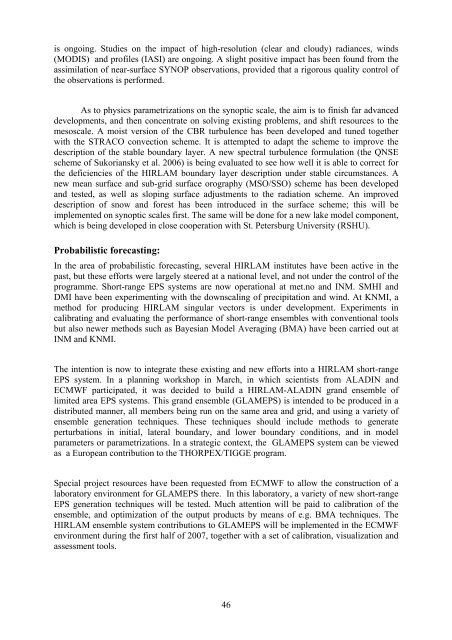Proceedings - C-SRNWP Project
Proceedings - C-SRNWP Project
Proceedings - C-SRNWP Project
You also want an ePaper? Increase the reach of your titles
YUMPU automatically turns print PDFs into web optimized ePapers that Google loves.
is ongoing. Studies on the impact of high-resolution (clear and cloudy) radiances, winds<br />
(MODIS) and profiles (IASI) are ongoing. A slight positive impact has been found from the<br />
assimilation of near-surface SYNOP observations, provided that a rigorous quality control of<br />
the observations is performed.<br />
As to physics parametrizations on the synoptic scale, the aim is to finish far advanced<br />
developments, and then concentrate on solving existing problems, and shift resources to the<br />
mesoscale. A moist version of the CBR turbulence has been developed and tuned together<br />
with the STRACO convection scheme. It is attempted to adapt the scheme to improve the<br />
description of the stable boundary layer. A new spectral turbulence formulation (the QNSE<br />
scheme of Sukoriansky et al. 2006) is being evaluated to see how well it is able to correct for<br />
the deficiencies of the HIRLAM boundary layer description under stable circumstances. A<br />
new mean surface and sub-grid surface orography (MSO/SSO) scheme has been developed<br />
and tested, as well as sloping surface adjustments to the radiation scheme. An improved<br />
description of snow and forest has been introduced in the surface scheme; this will be<br />
implemented on synoptic scales first. The same will be done for a new lake model component,<br />
which is being developed in close cooperation with St. Petersburg University (RSHU).<br />
Probabilistic forecasting:<br />
In the area of probabilistic forecasting, several HIRLAM institutes have been active in the<br />
past, but these efforts were largely steered at a national level, and not under the control of the<br />
programme. Short-range EPS systems are now operational at met.no and INM. SMHI and<br />
DMI have been experimenting with the downscaling of precipitation and wind. At KNMI, a<br />
method for producing HIRLAM singular vectors is under development. Experiments in<br />
calibrating and evaluating the performance of short-range ensembles with conventional tools<br />
but also newer methods such as Bayesian Model Averaging (BMA) have been carried out at<br />
INM and KNMI.<br />
The intention is now to integrate these existing and new efforts into a HIRLAM short-range<br />
EPS system. In a planning workshop in March, in which scientists from ALADIN and<br />
ECMWF participated, it was decided to build a HIRLAM-ALADIN grand ensemble of<br />
limited area EPS systems. This grand ensemble (GLAMEPS) is intended to be produced in a<br />
distributed manner, all members being run on the same area and grid, and using a variety of<br />
ensemble generation techniques. These techniques should include methods to generate<br />
perturbations in initial, lateral boundary, and lower boundary conditions, and in model<br />
parameters or parametrizations. In a strategic context, the GLAMEPS system can be viewed<br />
as a European contribution to the THORPEX/TIGGE program.<br />
Special project resources have been requested from ECMWF to allow the construction of a<br />
laboratory environment for GLAMEPS there. In this laboratory, a variety of new short-range<br />
EPS generation techniques will be tested. Much attention will be paid to calibration of the<br />
ensemble, and optimization of the output products by means of e.g. BMA techniques. The<br />
HIRLAM ensemble system contributions to GLAMEPS will be implemented in the ECMWF<br />
environment during the first half of 2007, together with a set of calibration, visualization and<br />
assessment tools.<br />
46

















